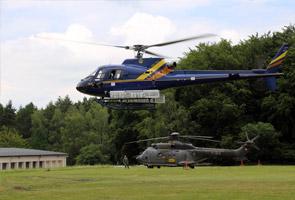Radioactivity measurements from the air: IRSN joined its first international exercise

From 14 to 19 June 2015, IRSN took part in a European exercise of airborne measurements of radioactivity using helicopters organized in Chemnitz (Germany), near the Czech border. Three other teams were also present: the BfS for Germany, SÚRO for the Czech Republic and the NAZ for Switzerland.
The exercise was focused on coordination and cooperation between neighboring European countries. In the event of a nuclear accident, joint measurements are indeed the fastest and most reliable approach for diagnosing the extent of the fallout over large areas and thus decide which measures need to be taken for the protection of the population.
To maximize the benefit from this exercise, measurement practices took place on a complex territory on both sides of the border between Germany and the Czech Republic, on areas with a legacy of pollution from uranium mining. Teams were evaluated on the reliability of their measurements and their ability to coordinate through three tasks:
- Comparative measurements over the same area;
- Identification of radioactive substances of low activity;
- Production of a map in coordination with the other participants.
The Chemnitz’s exercise was the fourth of its kind since 2003, but the first since the 2011’s Fukushima Daiichi nuclear accident. In Japan, airborne measurement had been the fastest and most reliable technique to provide public authorities with a first assessment of the radioactive fallout from the Fukushima nuclear power plant.
Joint measurements campaign was also a first for IRSN and its mobile measuring system named Ulysse, launched in late 2011. Outside crisis periods, Ulysse have already been used several times in France because this technique proves to be particularly precise to perform environmental measures on localized areas.This exercise was also a consistency check for Ulysse with systems developed by German, Czech and Swiss teams, which have accumulated experience of nearly twenty years.
